Ronald J. Anderson - Introduction to Mechanical Vibrations
Здесь есть возможность читать онлайн «Ronald J. Anderson - Introduction to Mechanical Vibrations» — ознакомительный отрывок электронной книги совершенно бесплатно, а после прочтения отрывка купить полную версию. В некоторых случаях можно слушать аудио, скачать через торрент в формате fb2 и присутствует краткое содержание. Жанр: unrecognised, на английском языке. Описание произведения, (предисловие) а так же отзывы посетителей доступны на портале библиотеки ЛибКат.
- Название:Introduction to Mechanical Vibrations
- Автор:
- Жанр:
- Год:неизвестен
- ISBN:нет данных
- Рейтинг книги:4 / 5. Голосов: 1
-
Избранное:Добавить в избранное
- Отзывы:
-
Ваша оценка:
Introduction to Mechanical Vibrations: краткое содержание, описание и аннотация
Предлагаем к чтению аннотацию, описание, краткое содержание или предисловие (зависит от того, что написал сам автор книги «Introduction to Mechanical Vibrations»). Если вы не нашли необходимую информацию о книге — напишите в комментариях, мы постараемся отыскать её.
is a definitive resource. The text extensively covers foundational knowledge in the field and uses it to lead up to and include: finite elements, the inerter, Discrete Fourier Transforms, flow-induced vibrations, and self-excited oscillations in rail vehicles.
The text aims to accomplish two things in a single, introductory, semester-length, course in vibrations. The primary goal is to present the basics of vibrations in a manner that promotes understanding and interest while building a foundation of knowledge in the field. The secondary goal is to give students a good understanding of two topics that are ubiquitous in today's engineering workplace – finite element analysis (FEA) and Discrete Fourier Transforms (the DFT- most often seen in the form of the Fast Fourier Transform or FFT). FEA and FFT software tools are readily available to both students and practicing engineers and they need to be used with understanding and a degree of caution. While these two subjects fit nicely into vibrations, this book presents them in a way that emphasizes understanding of the underlying principles so that students are aware of both the power and the limitations of the methods.
In addition to covering all the topics that make up an introductory knowledge of vibrations, the book includes:
● End of chapter exercises to help students review key topics and definitions
● Access to sample data files, software, and animations via a dedicated website

 , associated with the generalized coordinate,
, associated with the generalized coordinate,  , accounts for the effect of externally applied forces that are not included in the potential energy. We normally include elastic (i.e. spring) forces and gravitational forces in the potential energy and all others enter through the use of generalized forces.
, accounts for the effect of externally applied forces that are not included in the potential energy. We normally include elastic (i.e. spring) forces and gravitational forces in the potential energy and all others enter through the use of generalized forces.

 to be the generalized force ,
to be the generalized force ,  , where
, where
 and the damping coefficient (constant of proportionality) is
and the damping coefficient (constant of proportionality) is  . The physical connection of the damper to both the ground and the body dictates that the rate of change of length of the damper is equal to the speed
. The physical connection of the damper to both the ground and the body dictates that the rate of change of length of the damper is equal to the speed  . The force in the damper will therefore be
. The force in the damper will therefore be  . The direction of the force will be such that it causes the damper to increase in length as shown in the lower part of Figure 1.4. By Newton's 3rd Law, the force on the body must be equal and opposite to the force acting on the damper. The force
. The direction of the force will be such that it causes the damper to increase in length as shown in the lower part of Figure 1.4. By Newton's 3rd Law, the force on the body must be equal and opposite to the force acting on the damper. The force  therefore acts to the left on the body. In other words, the damping force opposes the velocity of the body.
therefore acts to the left on the body. In other words, the damping force opposes the velocity of the body.

 can be substituted into Equation 1.26to get the following expression for the generalized force arising from the damper
can be substituted into Equation 1.26to get the following expression for the generalized force arising from the damper















